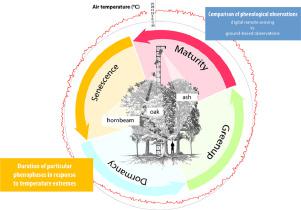当前位置:
X-MOL 学术
›
Agric. For. Meteorol.
›
论文详情
Our official English website, www.x-mol.net, welcomes your feedback! (Note: you will need to create a separate account there.)
Comparison of traditional ground-based observations and digital remote sensing of phenological transitions in a floodplain forest
Agricultural and Forest Meteorology ( IF 6.2 ) Pub Date : 2020-09-01 , DOI: 10.1016/j.agrformet.2020.108079 Ondřej Nezval , Jan Krejza , Jan Světlík , Ladislav Šigut , Petr Horáček
Agricultural and Forest Meteorology ( IF 6.2 ) Pub Date : 2020-09-01 , DOI: 10.1016/j.agrformet.2020.108079 Ondřej Nezval , Jan Krejza , Jan Světlík , Ladislav Šigut , Petr Horáček

|
Abstract Phenological observations are important as indicators of global warming and as estimation tools for the terrestrial carbon balance in vulnerable ecosystems, such as the last fragments of floodplain forests in the Czechia. The aim of this paper was to compare ground-based phenological observations of three dominant species (European hornbeam, English oak and narrow-leaved ash) in this ecosystem, with the seasonal trajectory of the greenness index (Gcc) and thresholds extracted from images taken by phenocameras located on a meteorological mast. The average annual air temperature in the studied years 2014–2017 was 1 °C higher than the long-term average, and the precipitation deficit reached ⅓ of annual rainfall. We found a high proportion of above-average warm days in the warmest part of the growing season. Above-average air temperatures significantly accelerated the onset of budbreak in ash. Yet a higher proportion of above-average air temperatures prolonged the period between budbreak to fully developed leaf area, especially in ash and oak. In 2017, rapid cooling after exceptionally warm temperatures at the onset of spring had a detrimental effect on the stand productivity and showed a marked effect on the phenological shifts. The period when leaf area developed was in the range of DOY 66-286 for hornbeam, DOY 79-329 for oak and DOY 88-321 for ash in 2014–2017. The seasonal trajectory of Gcc showed differences between tree species that corresponded to the dynamics of the onset of phenophases observed in the field. According to image analyses, the phenophase of greenup and maturity for hornbeam and ash had minimal uncertainty. In contrast, the uncertainty was high in the determination of phenophases for oak. Our observations show that the modern method of phenological observation by phenocameras is suitable for mixed forests, but classical ground-based observations by a phenologist are still crucial in order to verify the results.
中文翻译:

洪泛区森林物候转变的传统地面观测与数字遥感的比较
摘要 物候观测作为全球变暖的指标和脆弱生态系统中陆地碳平衡的估计工具非常重要,例如捷克洪泛区森林的最后碎片。本文的目的是比较该生态系统中三种优势物种(欧洲角树、英国橡树和窄叶灰)的地面物候观测结果,以及从拍摄的图像中提取的绿色指数 (Gcc) 和阈值的季节性轨迹。由位于气象桅杆上的 phenocameras 拍摄。2014-2017年研究年平均气温比长期平均值高1℃,降水亏缺达到年降水量的1/3。我们发现在生长季节最温暖的部分有很大比例的温暖天数高于平均水平。高于平均水平的气温显着加速了灰烬萌芽的开始。然而,高于平均气温的较高比例延长了萌芽到完全发育的叶面积之间的时间,特别是在白蜡树和橡树中。2017 年,春季开始异常温暖的气温后的快速降温对林分生产力产生了不利影响,并对物候变化产生了显着影响。2014-2017 年,角树叶面积发育期为 DOY 66-286,橡木为 DOY 79-329,白蜡木为 DOY 88-321。Gcc 的季节性轨迹显示了树种之间的差异,这与在现场观察到的物候期开始的动态相对应。根据图像分析,角树和灰烬的发绿和成熟的物候期具有最小的不确定性。相比之下,橡木物候期测定的不确定性很高。我们的观察表明,现代物候观测方法适用于混交林,但物候学家的经典地面观测对于验证结果仍然至关重要。
更新日期:2020-09-01
中文翻译:

洪泛区森林物候转变的传统地面观测与数字遥感的比较
摘要 物候观测作为全球变暖的指标和脆弱生态系统中陆地碳平衡的估计工具非常重要,例如捷克洪泛区森林的最后碎片。本文的目的是比较该生态系统中三种优势物种(欧洲角树、英国橡树和窄叶灰)的地面物候观测结果,以及从拍摄的图像中提取的绿色指数 (Gcc) 和阈值的季节性轨迹。由位于气象桅杆上的 phenocameras 拍摄。2014-2017年研究年平均气温比长期平均值高1℃,降水亏缺达到年降水量的1/3。我们发现在生长季节最温暖的部分有很大比例的温暖天数高于平均水平。高于平均水平的气温显着加速了灰烬萌芽的开始。然而,高于平均气温的较高比例延长了萌芽到完全发育的叶面积之间的时间,特别是在白蜡树和橡树中。2017 年,春季开始异常温暖的气温后的快速降温对林分生产力产生了不利影响,并对物候变化产生了显着影响。2014-2017 年,角树叶面积发育期为 DOY 66-286,橡木为 DOY 79-329,白蜡木为 DOY 88-321。Gcc 的季节性轨迹显示了树种之间的差异,这与在现场观察到的物候期开始的动态相对应。根据图像分析,角树和灰烬的发绿和成熟的物候期具有最小的不确定性。相比之下,橡木物候期测定的不确定性很高。我们的观察表明,现代物候观测方法适用于混交林,但物候学家的经典地面观测对于验证结果仍然至关重要。



























 京公网安备 11010802027423号
京公网安备 11010802027423号